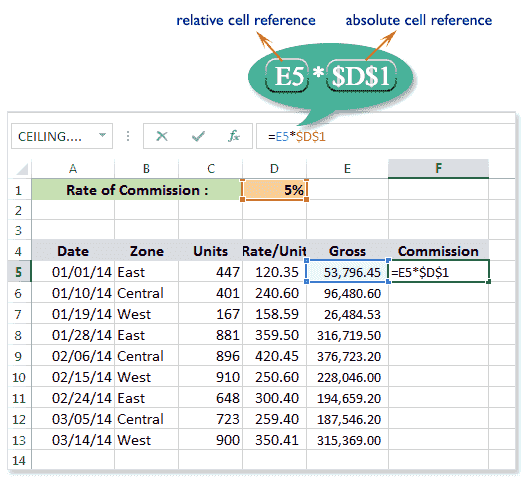
Here is an explanation of how Excel uses references as variables. Relative References in Excel are Variables See the lesson on multiplication in Excel for another example of referencing cells. Referencing cells can be used with all kinds of formulas and equations in Excel. If we change any of the values in cells A1 or B1, the value in C1 will automatically update.Įxample: If we change the value of B1 to 9, then C1 automatically updates to 18 which is 9+9. First, open Sample File.xlsx available online. An absolute reference in Excel is a cell that isnt altered by copying a formula. This is what happens when we copy the formula in cell C2 to cell C3. In cell C1 we will add these two values together by typing “=A1+B1” (without quotation marks) As you can see in the example above, in all four cells, the first part of the formula is a relative cell reference and the second part is an absolute cell reference. You can reference more than one cell at a time as part of an equation.Įxample: Add the values of two cells together. Relative references change when a formula is copied to another cell whereas Absolute references, remain constant, no matter where they are copied. Each behaves differently when copied and filled to other cells. Watch the video below to learn more about cell references.
#Relative cell reference excel practice download#
Optional: Download our practice workbook. Absolute references, on the other hand, remain constant no matter where they are copied. Relative references change when a formula is copied to another cell.

In this tutorial you will learn the differences between relative and absolute cell references. Relative and absolute references behave differently when copied and filled to other cells. The value in A3 automatically changes to 9 as well.Įxcel can take the values from different cells and plug them into all kinds of equations and formulas. These cells can be referred to by Excel Formulas when calcuations are made. The benefit of doing this is that if we change the value in cell A1, the value in our referenced cell automatically changes too.Įxample: Change the value in A1 to 9 and type enter.

Notice that the formula bar still shows “=A1” as the contents of cell A3, but the value from A1 is what we see in the cell. The value of 2 from cell A1 appears in cell A3. This will also automatically enter the name of the cell A1 into the new cell. You can either type =A1 or you can type the = symbol and then click on the cell A1.
#Relative cell reference excel practice how to#
You may learn more about excel from the following articles. Learn what is an absolute reference in excel, how to create an absolute cell reference, and how to use an absolute cell reference. Next, click on cell A3 and type “=A1” (without the quotation marks). Here we discuss the three types of Cell References in excel (absolute, relative, and mixed) and how to each of them along with practical examples and a downloadable excel template. We want to reference the value in cell A1 in cell A3. To reference another cell, type the = symbol and then the name of the cell you want to reference. In our example, we want to reference cell E14 on the Menu Order worksheet.Video Source (03:06 mins) | Transcript Referencing Cells Locate the cell you want to reference, and note its worksheet. A relative addresses will change when copied to other location in a worksheet because it describes the 'offset' to another cell, rather than a fixed address. For example, a relative reference to cell A1 looks like this: A1. Now copy cell A1 and paste it to cell A3. A relative reference in Excel is a pointer to a cell or range of cells. What is a relative reference in excel When you copy a cell containing a relative reference and paste it into another cell, the relative reference changes. Excel uses relative references by default. This will allow us to use the exact same value on two different worksheets without rewriting the formula or copying data. A1 contains the reference to B1 so both cells now show the number 11. In our example below, we'll refer to a cell with a calculated value between two worksheets.

For example, if you wanted to reference cell A1 on a worksheet named July Budget, its cell reference would be 'July Budget'!A1. Note that if a worksheet name contains a space, you'll need to include single quotation marks (' ') around the name.

For example, if you wanted to reference cell A1 on Sheet1, its cell reference would be Sheet1!A1. To do this, you'll simply need to begin the cell reference with the worksheet name followed by an exclamation point (!). Using cell references with multiple worksheetsĮxcel allows you to refer to any cell on any worksheet, which can be especially helpful if you want to reference a specific value from one worksheet to another.


 0 kommentar(er)
0 kommentar(er)
